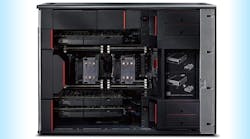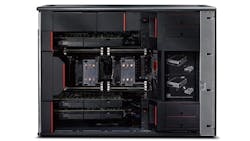We’ve all seen those car commercials with the (typically obnoxious) announcer telling audiences “now is the time to buy!” and offering deals that are “unheard of!” Of course, we all know that these ads are a dime a dozen, and those of us considering purchasing a new car need only wait a few weeks for another deal to roll around. And that, they’ll promise, will really be the time to buy.
Purchasing a workstation can be a lot like buying a car. Often you’ll seek to upgrade your system on a predetermined cycle (typically every three years), and look for those machines that offer the best combination of price and performance, depending on the features most critical to your business and the technology available. For the most part, this approach works just fine.
However, the last year has been an extraordinary one for workstations, with a confluence of events in the market that’s extremely rare for the industry. So at the risk of sounding like one of those obnoxious car commercial announcers, I’m here to tell you that regardless of where you are in your upgrade cycle, now is the time to buy. Really.
This file type includes high resolution graphics and schematics when applicable.
A Perfect Storm
So why do you need to be thinking about a workstation upgrade now, regardless of whether you’re considering one or not? The reason is simple: The last year has seen the “perfect storm” of new technologies hitting the marketplace—a rare confluence of CPU, GPU storage, and workstation hardware that gives users the ability to upgrade nearly every aspect of their machines and boost productivity in every important area.
This is a once-in-a-blue-moon phenomenon. Usually, vendors will launch a new graphics card or CPU three months, six months, or even a full year after a new workstation is released or new storage offerings become available, or vice versa. This forces users to purchase these components separately after they’ve upgraded their machine, creating less opportunity to get maximum value out of the components before they need to upgrade again. It’s not cost-effective, but based on typical practices, it’s just something engineers have had to live with.
That’s why the last year has been so special. With new technologies coming to market across multiple key categories, users now have the opportunity to get a complete upgrade and maximum value out of all their components without worrying that something brand new will pop up in a month, forcing them to buy a component that didn’t come with the machine.
It’s an extraordinary opportunity to get a complete refresh for your business, and one everyone in the electronic design industry should think about seizing on to gain a competitive advantage. Even if you’re not actively considering an upgrade, the opportunity to gain a leg up on the competition and a boost in productivity should make you think twice.
The Best Hardware Money Can Buy…Collectively
Some of the new technologies that have emerged in the last year make upgrading not only attractive, but downright essential:
CPU: In September of 2014, Intel launched its Haswell-EP Xeon processors. This latest generation of its CPU technology represents a quantum leap in performance from the previous generation chipsets. Haswell-EP Xeon technology features up to 18 cores per processor—a 50% increase from the last version (which supported only 12). This means for a workstation that supports two CPUs, you’re looking at having access to 36 cores as opposed to the previous generation’s 24. It’s a monster performance boost that should be a no-brainer for designers looking for an edge.
Storage: The recent emergence of solid-state drives (SSDs) and M.2 cards have changed the landscape for hard-drive technology, providing highly affordable drives that are significantly faster than the previous generation’s disk-based standards.
While SSDs have proven more popular than M.2 cards due to greater user familiarity with the technology, M.2 drives can actually be a more cost-effective option, delivering a significant gain in performance (and improvement over previous technology) at a cost within reach of the average electronic designer. Whatever you choose, newer workstation solutions have the flexibility to support both of these storage technologies, which makes upgrading that much more attractive.
GPU: Though electronic design doesn’t exactly scream “graphics-intensive applications,” the latest wave of graphics cards is a doozy, turning it into a strong “good to have” for a workstation. Specifically, NVIDIA introduced five new Quadro cards last August—the K420, K620, K2200, K4200, and K5200, which complement its K6000 that was launched in the months prior. These new cards are 40% faster than previous cards when it comes to professional applications. And with so many options available, even cost-strapped designers who don’t feel they can afford higher-end cards or that they need such significant graphics performance can still get a boost for their applications.
Workstations
Updates weren’t just relegated to components. Workstations underwent a tremendous change in the last year. Multiple vendors brought new systems to the market that offer support for all of the above-mentioned components, as well as many other strong features.
An example is the Lenovo ThinkStation P Series, which features a redesigned chassis. The series models—P300, P500, P700, and P900—offer a range of configurations that should fit most business needs (see the figure). The systems support the aforementioned components, as integrate thermal management that helps boost machine reliability. An intuitive system of red touchpoints facilitates upgrading.
It’s a far cry from previous generations, and when taken with the other technology advances introduced over the last year, it represents a considerable leap forward for workstation innovation.
This file type includes high resolution graphics and schematics when applicable.
Conclusion
Nobody wants to be told that they need to buy something, but if you consider your workstation a critical enabler of your electronic design business, now is an ideal time to consider an upgrade. With the recent advances in CPUs, storage, and GPU, as well as workstation technology, there simply hasn’t been a better time to maximize your workstation investment, and there likely won’t be again for a long time.



